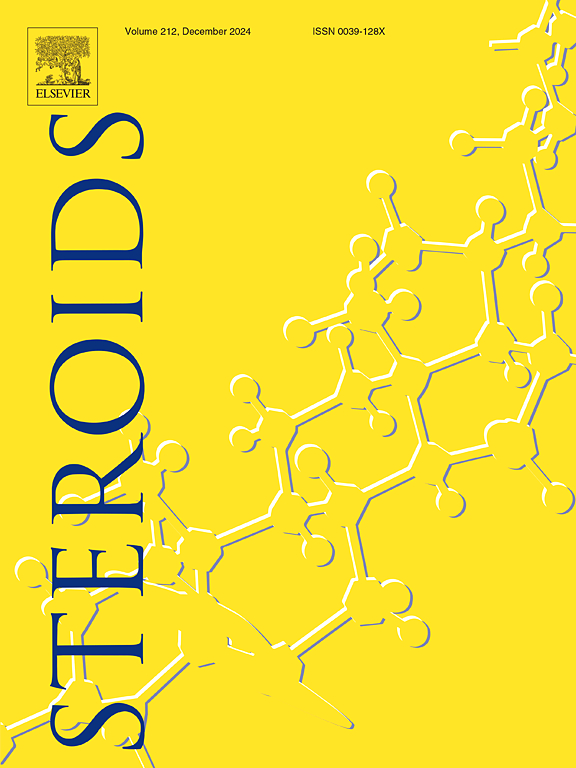SPRY4 可调节 ERK1/2 磷酸化,从而影响多囊卵巢综合征的氧化应激和类固醇生成。
IF 2.1
4区 医学
Q4 BIOCHEMISTRY & MOLECULAR BIOLOGY
引用次数: 0
摘要
多囊卵巢综合征(PCOS)是育龄妇女普遍存在的一种内分泌疾病。本文研究了 Sprouty RTK 信号拮抗剂 4(SPRY4)在多囊卵巢综合征卵巢功能中的作用,重点是其对 ERK1/2 磷酸化的调控。研究人员使用脱氢表雄酮(DHEA)在小鼠体内建立了多囊卵巢综合征模型。通过 RT-qPCR 和免疫组化分析了 SPRY4 在卵巢组织中的表达水平。通过慢病毒敲除 SPRY4,并评估其对内分泌功能、卵巢形态、氧化应激和 ERK1/2 磷酸化的影响。随后,分离颗粒细胞并用 DHEA 和 ERK2 激动剂叔丁基对苯二酚处理。使用酶联免疫吸附试验、荧光探针、Western印迹和生化试验评估了ERK2激活对SPRY4敲除调节的影响。SPRY4敲除可使发情周期正常化,降低血清中睾酮、抗苗勒氏激素和黄体生成素/卵泡刺激素的比率,并改善卵巢形态。此外,SPRY4 基因敲除还能降低活性氧和丙二醛水平,同时提高超氧化物歧化酶的活性,从而缓解氧化应激。它还恢复了被DHEA诱导破坏的类固醇生成酶的表达。在体外,SPRY4基因敲除增强了颗粒细胞的活力,降低了ERK1/2磷酸化,而叔丁基对苯二酚则逆转了这些影响,恢复了氧化应激和类固醇生成紊乱。总之,SPRY4 可调节 ERK1/2 磷酸化,从而影响多囊卵巢综合征的氧化应激和类固醇生成。靶向 SPRY4 可为改善卵巢功能和控制多囊卵巢综合症提供新的治疗途径。本文章由计算机程序翻译,如有差异,请以英文原文为准。
SPRY4 regulates ERK1/2 phosphorylation to affect oxidative stress and steroidogenesis in polycystic ovary syndrome
Polycystic ovary syndrome (PCOS) is a prevalent endocrine disorder in women of childbearing age. The role of Sprouty RTK Signaling Antagonist 4 (SPRY4) in ovarian function in PCOS was investigated herein, focusing on its regulation of ERK1/2 phosphorylation. PCOS models were established in mice using dehydroepiandrosterone (DHEA). The expression levels of SPRY4 in ovarian tissues were analyzed through RT-qPCR and immunohistochemistry. SPRY4 knockdown was achieved via lentivirus, and its effects on endocrine function, ovarian morphology, oxidative stress, and ERK1/2 phosphorylation were evaluated. Afterwards, granulosa cells were isolated and treated with DHEA and ERK2 agonist tert-Butylhydroquinone. The impacts of ERK2 activation on the regulation of SPRY4 knockdown were assessed using ELISA, fluorescent probes, western blotting, and biochemical assays. SPRY4 knockdown normalized the estrous cycle, reduced serum levels of testosterone, anti-Müllerian hormone, and luteinizing hormone/follicle-stimulating hormone ratio, and improved ovarian morphology. Additionally, SPRY4 knockdown alleviated oxidative stress by decreasing reactive oxygen species and malondialdehyde levels while increasing superoxide dismutase activity. It also restored steroidogenic enzyme expression, which were disrupted by DHEA induction. In vitro, SPRY4 knockdown enhanced granulosa cell viability and reduced ERK1/2 phosphorylation, with tert-Butylhydroquinone reversing these effects and restoring oxidative stress and steroidogenesis disruptions. Together, SPRY4 modulates ERK1/2 phosphorylation to influence oxidative stress and steroidogenesis in PCOS. Targeting SPRY4 may provide novel therapeutic avenues for improving ovarian function and managing PCOS.
求助全文
通过发布文献求助,成功后即可免费获取论文全文。
去求助
来源期刊

Steroids
医学-内分泌学与代谢
CiteScore
5.10
自引率
3.70%
发文量
120
审稿时长
73 days
期刊介绍:
STEROIDS is an international research journal devoted to studies on all chemical and biological aspects of steroidal moieties. The journal focuses on both experimental and theoretical studies on the biology, chemistry, biosynthesis, metabolism, molecular biology, physiology and pharmacology of steroids and other molecules that target or regulate steroid receptors. Manuscripts presenting clinical research related to steroids, steroid drug development, comparative endocrinology of steroid hormones, investigations on the mechanism of steroid action and steroid chemistry are all appropriate for submission for peer review. STEROIDS publishes both original research and timely reviews. For details concerning the preparation of manuscripts see Instructions to Authors, which is published in each issue of the journal.
 求助内容:
求助内容: 应助结果提醒方式:
应助结果提醒方式:


